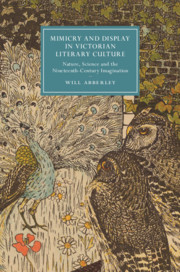 Mimicry and Display in Victorian Literary Culture
Mimicry and Display in Victorian Literary Culture Book contents
- Mimicry and Display in Victorian Literary Culture
- Cambridge Studies in Nineteenth-Century
- Mimicry and Display in Victorian Literary Culture
- Copyright page
- Contents
- Figures
- Acknowledgements
- Introduction
- Chapter 1 Seeing Things
- Chapter 2 Divine Displays
- Chapter 3 Criminal Chameleons
- Chapter 4 Darwin’s Little Ironies
- Chapter 5 Blending in and Standing out, I
- Chapter 6 Blending in and Standing out, II
- Conclusion
- Notes
- Bibliography
- Index
- Cambridge Studies in Nineteenth-Century Literature and Culture
Chapter 5 - Blending in and Standing out, I
Crypsis versus Individualism in Fin-de-Siècle Cultural Criticism
Published online by Cambridge University Press: 16 May 2020
- Mimicry and Display in Victorian Literary Culture
- Cambridge Studies in Nineteenth-Century
- Mimicry and Display in Victorian Literary Culture
- Copyright page
- Contents
- Figures
- Acknowledgements
- Introduction
- Chapter 1 Seeing Things
- Chapter 2 Divine Displays
- Chapter 3 Criminal Chameleons
- Chapter 4 Darwin’s Little Ironies
- Chapter 5 Blending in and Standing out, I
- Chapter 6 Blending in and Standing out, II
- Conclusion
- Notes
- Bibliography
- Index
- Cambridge Studies in Nineteenth-Century Literature and Culture
Summary
Chapter 5 contends that crypsis acted as a versatile trope by which fin-de-siècle literary and cultural critics thought through and complicated ideals of self-expression and originality. The critics discussed often invoked animal crypsis as a figure of conformity and bad faith, the opposite of authentic, autonomous expression. Such cryptophobic individualism is traced through the work of Lesley Stephen, Theodore Watts-Dunton, Walter Pater and Oscar Wilde, and its contradictions examined. Although the trope drew on the imagery of adaptive appearance, its ideal of authentic expression was incongruent with the latter’s semiotic logic. Further, several of the authors discussed worried that too much discursive individualism and authenticity would threaten social cohesion. Stephen’s and Watts-Dunton’s religious and literary criticism attacked cultural imitation and protective mimicry while fearing that their removal might presage violent revolution or degeneration. Walter Pater, conversely, concluded that all art was inherently mimetic, reworking elements from pre-existing sources. He suggested that individualism was attained by mixing eclectic influences, generating novel combinations. It would take Pater’s pupil, Oscar Wilde, though, to fully realise the radical implications of such mimetic individualism. His vision of artistic authenticity required eluding recognition so that, paradoxically, the artist truly stood out by blending in.
Keywords
- Type
- Chapter
- Information
- Mimicry and Display in Victorian Literary CultureNature, Science and the Nineteenth-Century Imagination, pp. 149 - 177Publisher: Cambridge University PressPrint publication year: 2020
